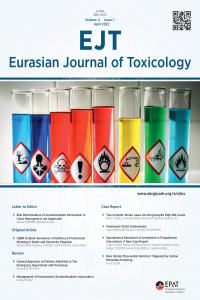Retrospective analysis of possible drug interactions in prescriptions written by branch and emergency physicians
ilaç etkileşimi, acil, aspirin, NSAID
Retrospective analysis of possible drug interactions in prescriptions written by branch and emergency physicians
Drug interaction, emergency, aspirin, NSAIDs,
___
- Referans1. Yıldırım AB, Kılınç AY. Yaşlıhastalarda polifarmasi ve ilaç etkileşimi [Polypharmacy and drug interactions in elderly patients]. Turk Kardiyol Dern Ars. 2017;45(Suppl 5):17‐21. doi:10.5543/tkda.2017.92770
- Referans2. Jetha S. Polypharmacy, the Elderly, and Deprescribing. Consult Pharm. 2015;30(9):527‐532. doi:10.4140/TCP.n.2015.527
- REferans3. Farooqui R, Hoor T, Karim N, Muneer M. Potential Drug-Drug Interactions among Patients prescriptions collected from Medicine Out-patient Setting. Pak J Med Sci. 2018;34(1):144‐148. doi:10.12669/pjms.341.13986
- Referans4. Bucşa C, Farcaş A, Cazacu I, Leucuta D, Achimas-Cadariu A, Mogosan C, et al. M. How many potential drug-drug interactions cause adverse drug reactions in hospitalized patients?. Eur J Intern Med. 2013;24(1):27‐33. doi:10.1016/j.ejim.2012.09.011
- Referans5. Drug Interactions Checker, Medscape Online Resources. Available from: https://reference.medscape.com/drug-interactionchecker
- Referans6. Soherwardi S, Chogtu B, Fazal P. Surveillance of the potential Drug-Drug Interactions in the Medicine Department of a Tertiary Care Hospital. J Clin Diag Res. 2012;6(7):1258-1261.
- Referans7. van Leeuwen RW, Swart EL, Boven E, Boom FA, Schuitenmaker MG, Hugtenburg JG. Potential drug interactions in cancer therapy: a prevalence study using an advanced screening method. Ann Oncol. 2011;22(10):2334‐2341. doi:10.1093/annonc/mdq761
- Referans8. Kashyap M, D'Cruz S, Sachdev A, Tiwari P. Drug-drug interactions and their predictors: Results from Indian elderly inpatients. Pharm Pract (Granada). 2013;11(4):191‐195. doi:10.4321/s1886-36552013000400003
- Referans9. Roblek T, Vaupotic T, Mrhar A, Lainscak M. Drug-drug interaction software in clinical practice: a systematic review. Eur J Clin Pharmacol. 2015;71(2):131‐142. doi:10.1007/s00228-014-1786-7
- Refrans10. Obreli-Neto PR, Nobili A, de Oliveira Baldoni A, Guidoni CM, de Lyra Junior DP, Pilger D, et al. Adverse drug reactions caused by drug-drug interactions in elderly outpatients: a prospective cohort study. Eur J Clin Pharmacol. 2012;68(12):1667‐1676. doi:10.1007/s00228-012-1309-3
- Yayın Aralığı: Yılda 3 Sayı
- Başlangıç: 2019
- Yayıncı: Acil Tıp Uzmanları Derneği
Bahar KESKİN ÇELİK, Meryem BETOS KOÇAK, Bora ÇEKMEN, Turgut DOLANBAY, Sinem DOĞRUYOL
Nadir Görülen Bir İntoksikasyon Vakası: Izoniazid İntoksikasyonu
Necmi BAYKAN, Mustafa ALPASLAN, Polat DURUKAN
Kasım TURGUT, Ali GÜR, Abdullah Keyfo KAMA, Mehmet Gökhan TURTAY, Hakan OĞUZTÜRK
Siklosporin Kullanımının Nadir Bir Komplikasyonu:Nöbet
Hatice Şeyma AKÇA, Hayrullah YÖNAK, Murat BALCIOĞLU, Serkan Emre EROĞLU
Demographic Characteristics of Patients Applied to The Emergency Service with Drug Intoxications
Can YILDIZ, Ramazan KÖYLÜ, Yahya Kemal GÜNAYDIN, Belgin AKILLI, Göknur YILDIZ, Özge TURGAY YILDIRIM
